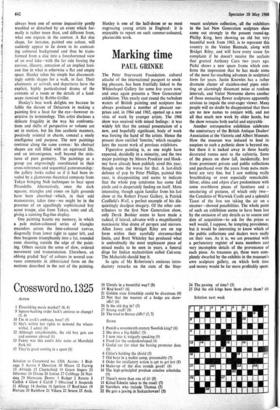Marking time
PAUL GRINKE
The Peter Stuyvesant Foundation, cultural attaché of the international passport to smok- ing pleasure, has been fruitfully linked to the Whitechapel Gallery for some five years now, and once again presents a `New Generation' exhibition. This yearly cast round the turbulent waters of British painting and sculpture has always produced a number of pleasant sur- prises and, in 1964 and 1965, opened up a new vista of work by younger artists. The 1966 show was received with mixed feelings: it was widely felt that the annual presentation of a new, and hopefully significant, body of work was forcing the hand of the artists. Hence the present show entitled 'Interim,' which recapitu- lates the recent work of previous exhibitors.
Figurative painting is, as one might have expected, decidedly in a minority, and the two major paintings by Messrs Procktor and Hock- ney have already been publicly aired this year, though none the worse for that. A last-ditch defence of pop by Peter Phillips, painted this year, is disappointing and seems to indicate that the whole pop syndrome has come full circle and is desperately feeding on itself. More interesting, though again familiar from his last show at the Robert Fraser Gallery, is Patrick Caulfield's Well, a perfect example of his dis- quietingly deadpan imagery. Of the other con- tributors to the first New Generation show, only Derek Boshier seems to have made a radical, if lateral, advance with a magnificently narcissistic blue dome of perspex and mirrors. Allen Jones and Bridget Riley are on top form within their carefully circumscribed limits, and Brett Whiteley has produced what is undoubtedly the most unpleasant piece of mixed media to be seen in years, a funeral dirge fot Indian malnutrition called Calcutta. The Maharishi should buy it.
In spite of Mr Robertson's ominous intro- ductory remarks on the state of the Stay- vesant sculpture collection, all the exhibitors in the last New Generation sculpture show come out strongly in the present round-up. Phillip King, here showing an old but very beautiful work from 1963, is to represent this country in the Venice Biennale, along with Bridget Riley, and will have every cause for complaint if he doesn't receive the acclaim that greeted Anthony Caro two years ago. Pichd shows a new space frame which con- firms the impression that he has made some of the most far-reaching advances in sculptural form for years. Justin Knowles has a rather dramatic cluster of stainless-steel pipes emit- ting an alarmingly dissonant noise at random intervals, and Victor Newsome shows another of those menacing flower sculptures apparently anxious to impale the over-eager viewer. Many people will no doubt be disappointed that there are no new names to conjure with, and not all that much new work by older hands, but the show remains both useful and enjoyable Another retrospective exhibition celebrates the anniversary of the British Antique Dealers' Association at the Victoria and Albert Museum. How the museum was induced to lend its auspices to such a pathetic show is beyond me, but there it is tucked away in three hastily decorated rooms next to the cafeteria. Some of the pieces on show (all, incidentally, lent from prominent private and public collections and purchased over the years from SADA mem- bers) are very fine, but I saw nothing really breathtaking or even especially remarkable. Silver, china and objets d'art predominate with some overblown pieces of furniture and a smattering of pictures, of which only two— the Canaletto of Warwick Castle and a splendid Tissot of the bon ton taking the air on a steamer—showed possibilities. The whole point of such an exhibition seems to have been lost by the omission of any details as to source and date of acquisition—to ask for the, prices as well would, I suppose, be tempting providence, but it would be interesting to know which of the public collections and dealers were really on their toes. As it is, we are presented with a perfunctory register of BADA members and very incomplete details of the provenance of each piece. As treasures go, these were com- pletely dwarfed by the exhibits in the museum's own sculpture gallery, on which both time and money would be far more profitably spent.






































 Previous page
Previous page